Accounting - Study Material with Solved Assignments, Essays, Dissertation
VerifiedAdded on 2023/05/28
|13
|1418
|120
AI Summary
This text provides study material on Accounting with solved assignments, essays, dissertation and answers to questions related to taxation, dividends, risk and return, and more.
Contribute Materials
Your contribution can guide someone’s learning journey. Share your
documents today.
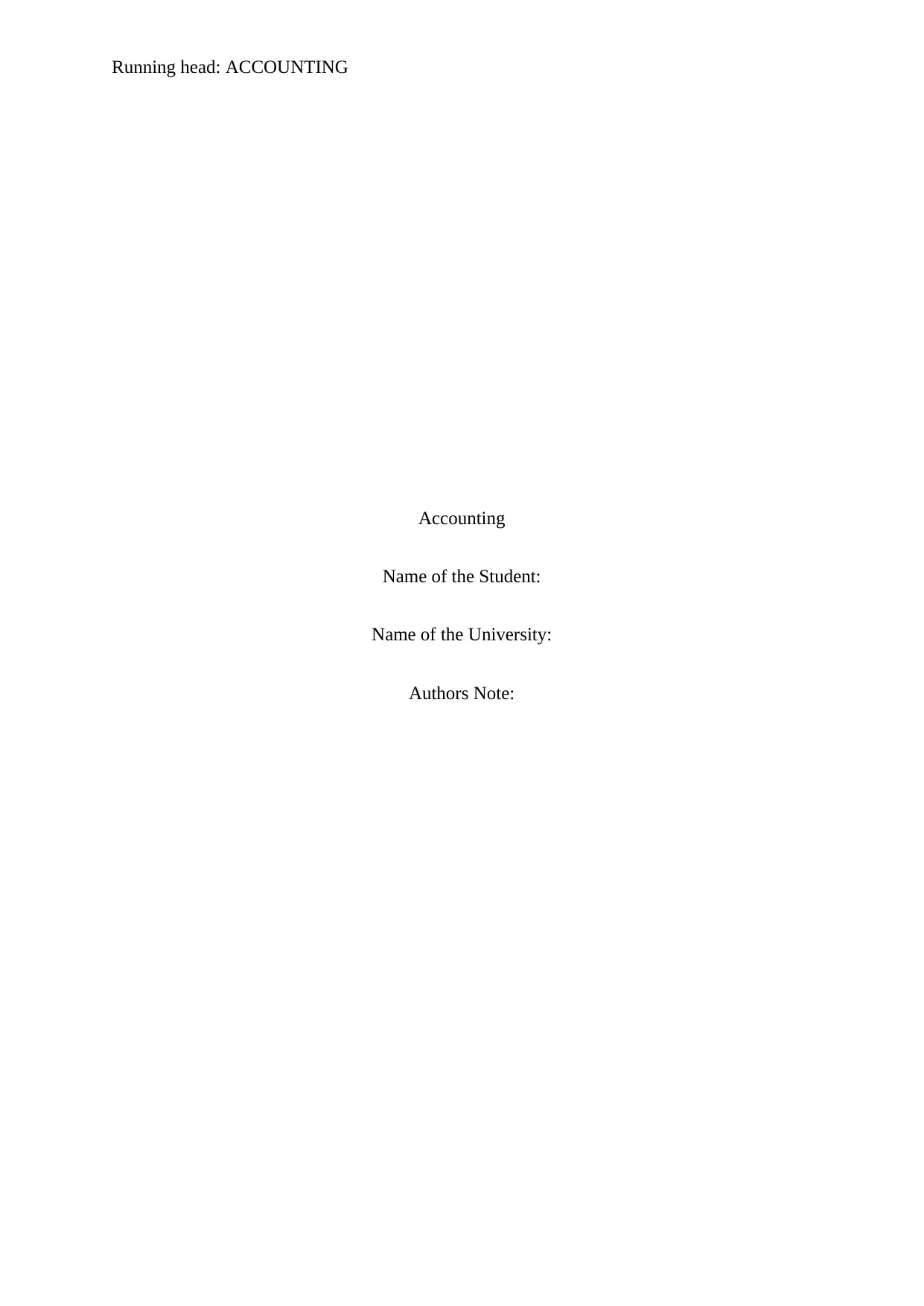
Running head: ACCOUNTING
Accounting
Name of the Student:
Name of the University:
Authors Note:
Accounting
Name of the Student:
Name of the University:
Authors Note:
Secure Best Marks with AI Grader
Need help grading? Try our AI Grader for instant feedback on your assignments.
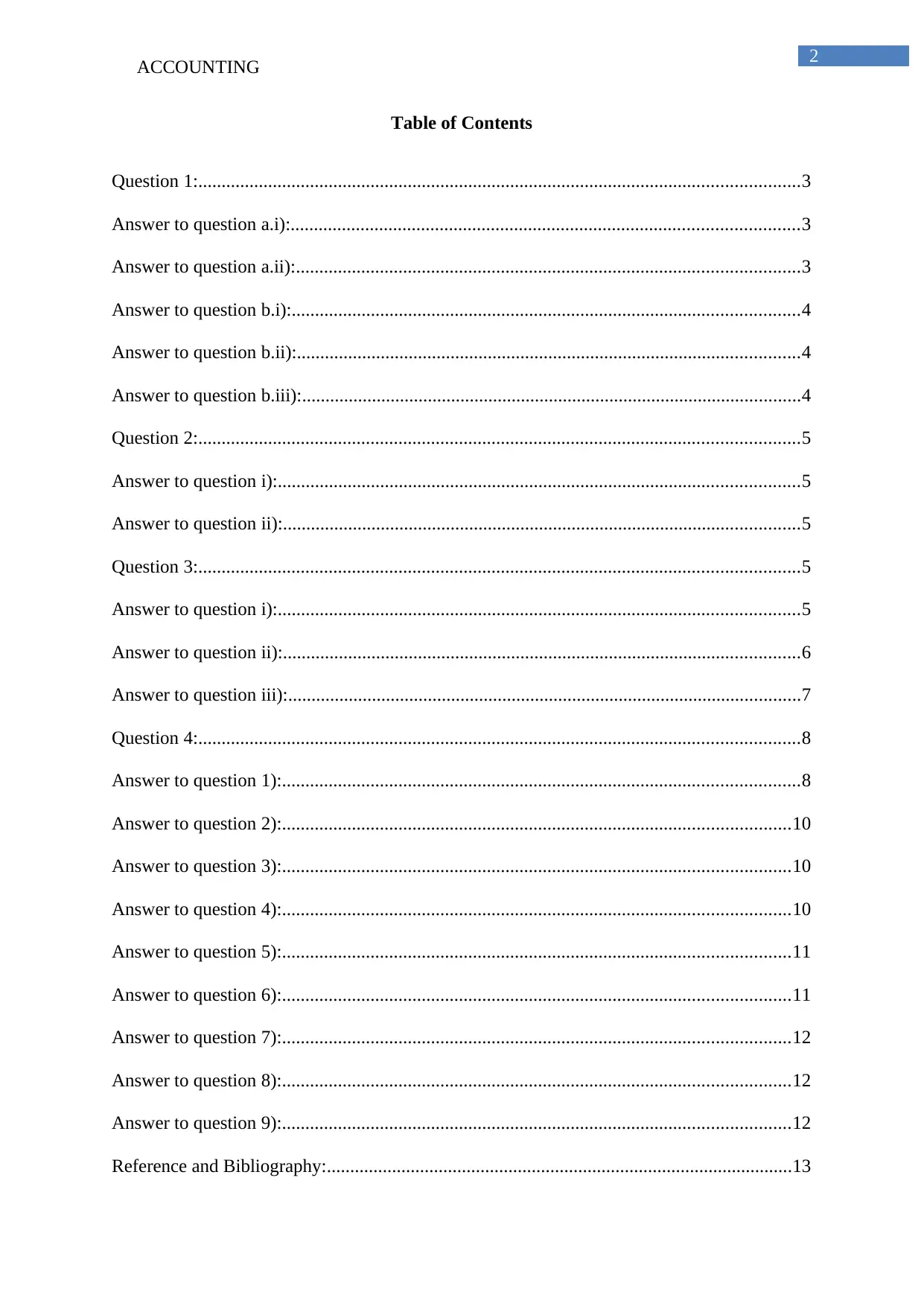
ACCOUNTING 2
Table of Contents
Question 1:.................................................................................................................................3
Answer to question a.i):.............................................................................................................3
Answer to question a.ii):............................................................................................................3
Answer to question b.i):.............................................................................................................4
Answer to question b.ii):............................................................................................................4
Answer to question b.iii):...........................................................................................................4
Question 2:.................................................................................................................................5
Answer to question i):................................................................................................................5
Answer to question ii):...............................................................................................................5
Question 3:.................................................................................................................................5
Answer to question i):................................................................................................................5
Answer to question ii):...............................................................................................................6
Answer to question iii):..............................................................................................................7
Question 4:.................................................................................................................................8
Answer to question 1):...............................................................................................................8
Answer to question 2):.............................................................................................................10
Answer to question 3):.............................................................................................................10
Answer to question 4):.............................................................................................................10
Answer to question 5):.............................................................................................................11
Answer to question 6):.............................................................................................................11
Answer to question 7):.............................................................................................................12
Answer to question 8):.............................................................................................................12
Answer to question 9):.............................................................................................................12
Reference and Bibliography:....................................................................................................13
Table of Contents
Question 1:.................................................................................................................................3
Answer to question a.i):.............................................................................................................3
Answer to question a.ii):............................................................................................................3
Answer to question b.i):.............................................................................................................4
Answer to question b.ii):............................................................................................................4
Answer to question b.iii):...........................................................................................................4
Question 2:.................................................................................................................................5
Answer to question i):................................................................................................................5
Answer to question ii):...............................................................................................................5
Question 3:.................................................................................................................................5
Answer to question i):................................................................................................................5
Answer to question ii):...............................................................................................................6
Answer to question iii):..............................................................................................................7
Question 4:.................................................................................................................................8
Answer to question 1):...............................................................................................................8
Answer to question 2):.............................................................................................................10
Answer to question 3):.............................................................................................................10
Answer to question 4):.............................................................................................................10
Answer to question 5):.............................................................................................................11
Answer to question 6):.............................................................................................................11
Answer to question 7):.............................................................................................................12
Answer to question 8):.............................................................................................................12
Answer to question 9):.............................................................................................................12
Reference and Bibliography:....................................................................................................13
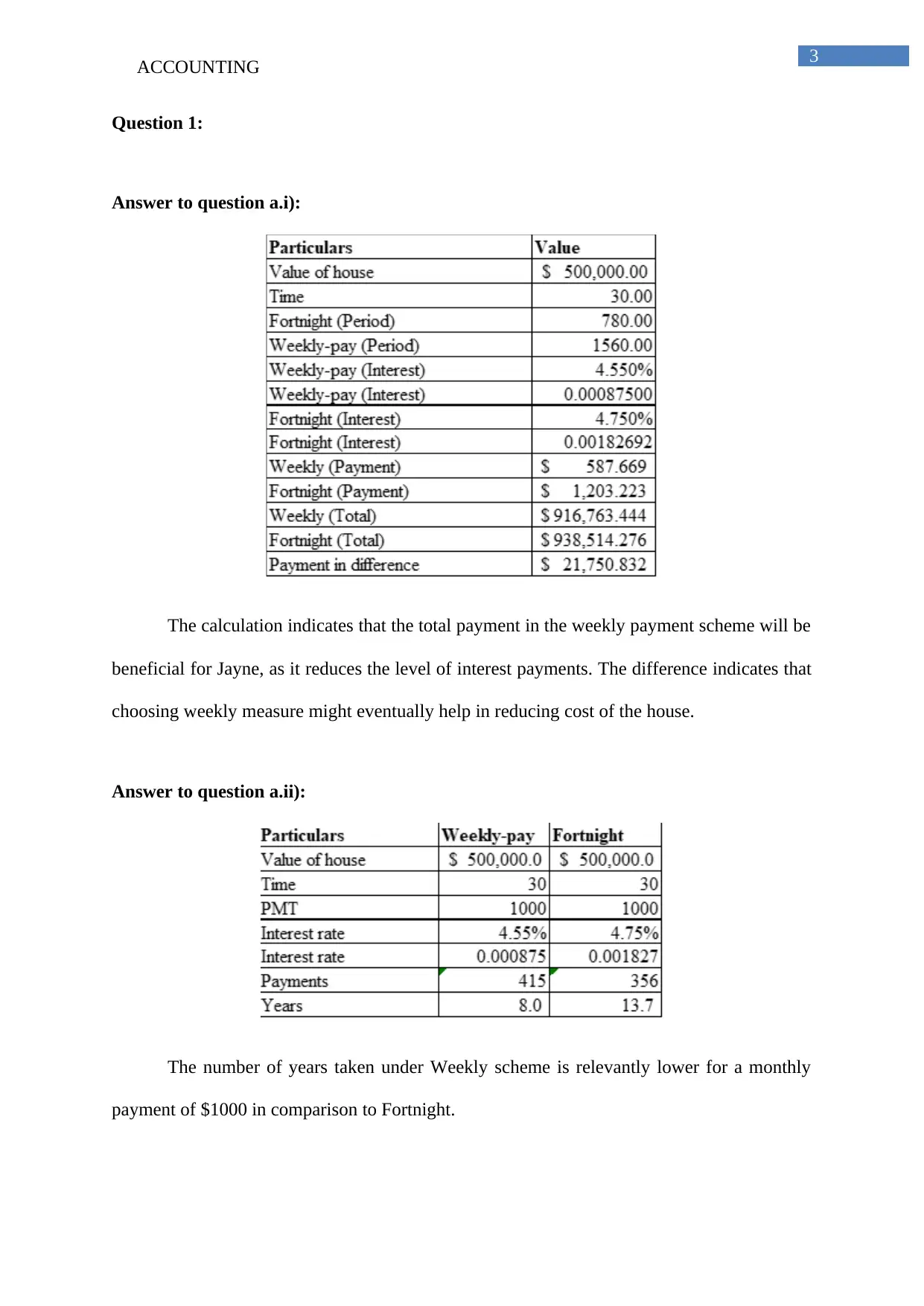
ACCOUNTING 3
Question 1:
Answer to question a.i):
The calculation indicates that the total payment in the weekly payment scheme will be
beneficial for Jayne, as it reduces the level of interest payments. The difference indicates that
choosing weekly measure might eventually help in reducing cost of the house.
Answer to question a.ii):
The number of years taken under Weekly scheme is relevantly lower for a monthly
payment of $1000 in comparison to Fortnight.
Question 1:
Answer to question a.i):
The calculation indicates that the total payment in the weekly payment scheme will be
beneficial for Jayne, as it reduces the level of interest payments. The difference indicates that
choosing weekly measure might eventually help in reducing cost of the house.
Answer to question a.ii):
The number of years taken under Weekly scheme is relevantly lower for a monthly
payment of $1000 in comparison to Fortnight.
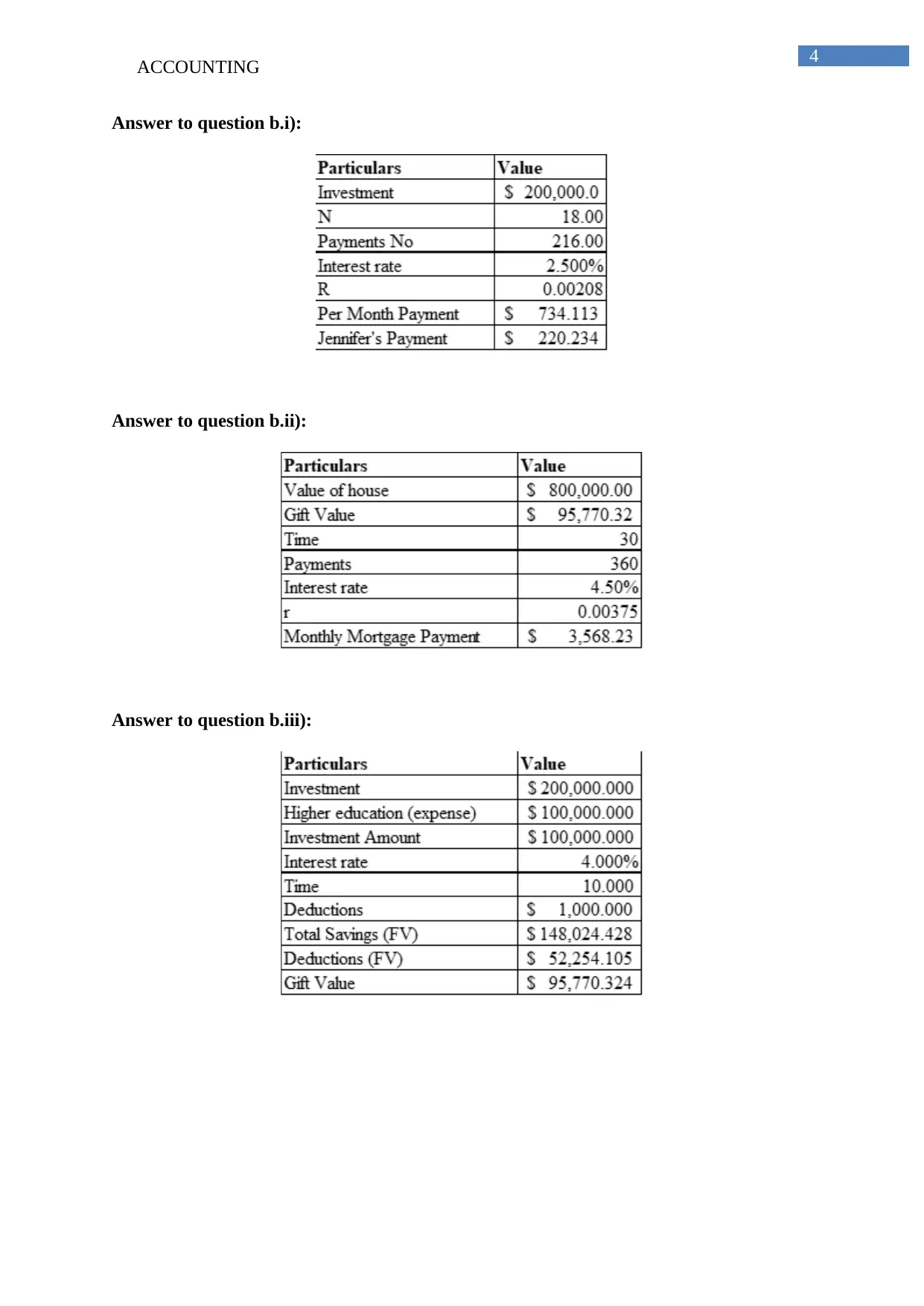
ACCOUNTING 4
Answer to question b.i):
Answer to question b.ii):
Answer to question b.iii):
Answer to question b.i):
Answer to question b.ii):
Answer to question b.iii):
Secure Best Marks with AI Grader
Need help grading? Try our AI Grader for instant feedback on your assignments.
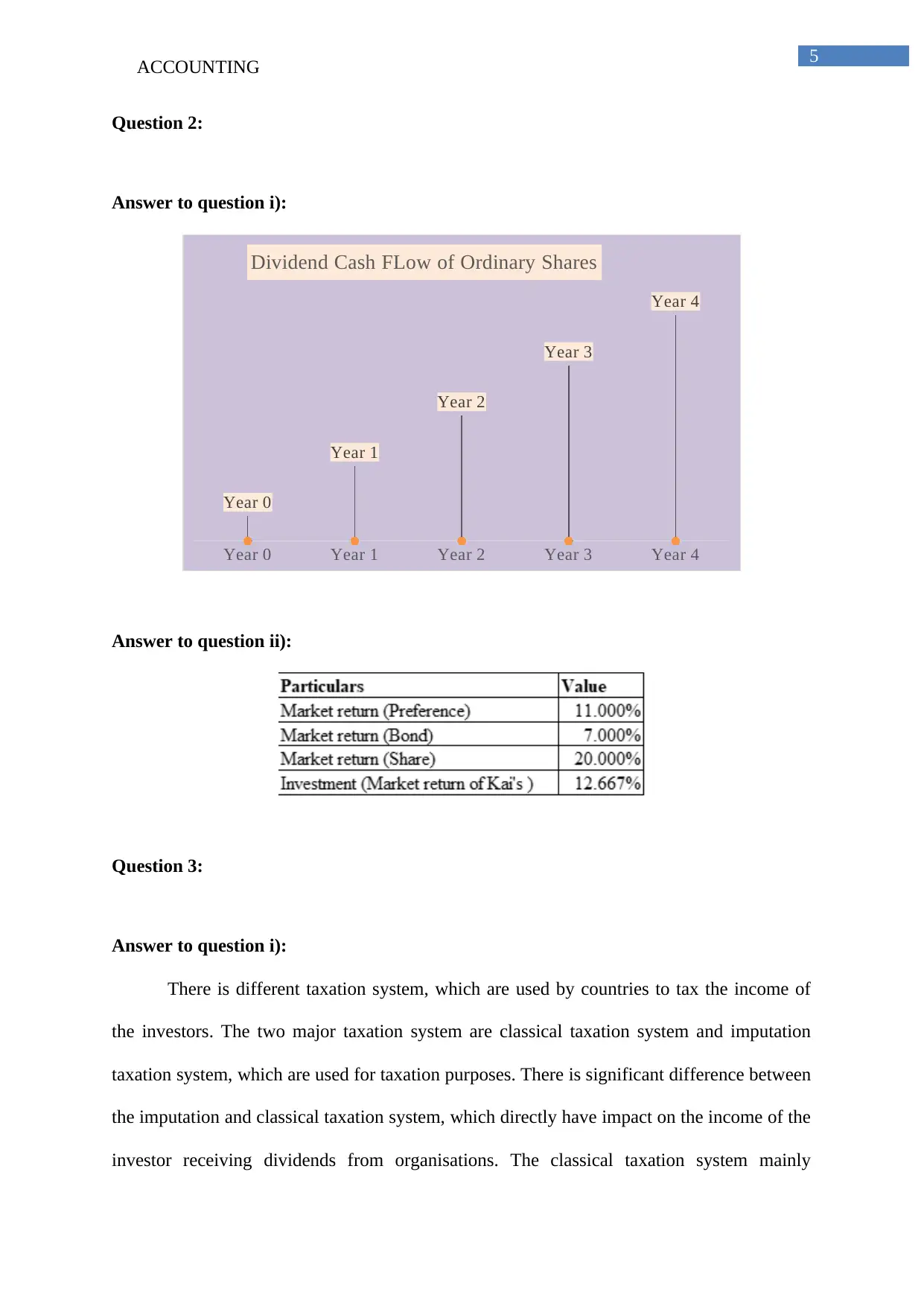
ACCOUNTING 5
Question 2:
Answer to question i):
Year 0 Year 1 Year 2 Year 3 Year 4
Year 0
Year 1
Year 2
Year 3
Year 4
Dividend Cash FLow of Ordinary Shares
Answer to question ii):
Question 3:
Answer to question i):
There is different taxation system, which are used by countries to tax the income of
the investors. The two major taxation system are classical taxation system and imputation
taxation system, which are used for taxation purposes. There is significant difference between
the imputation and classical taxation system, which directly have impact on the income of the
investor receiving dividends from organisations. The classical taxation system mainly
Question 2:
Answer to question i):
Year 0 Year 1 Year 2 Year 3 Year 4
Year 0
Year 1
Year 2
Year 3
Year 4
Dividend Cash FLow of Ordinary Shares
Answer to question ii):
Question 3:
Answer to question i):
There is different taxation system, which are used by countries to tax the income of
the investors. The two major taxation system are classical taxation system and imputation
taxation system, which are used for taxation purposes. There is significant difference between
the imputation and classical taxation system, which directly have impact on the income of the
investor receiving dividends from organisations. The classical taxation system mainly
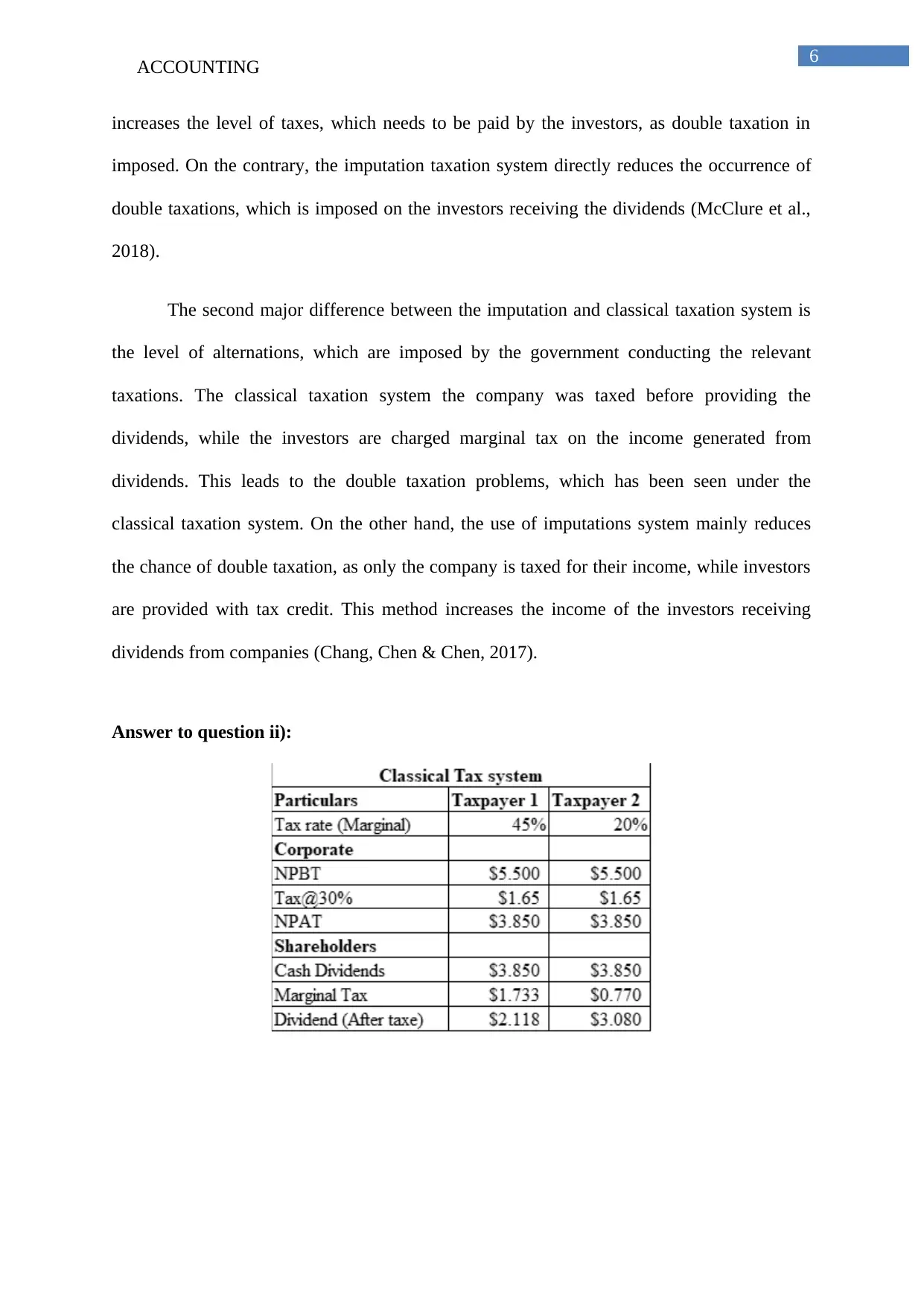
ACCOUNTING 6
increases the level of taxes, which needs to be paid by the investors, as double taxation in
imposed. On the contrary, the imputation taxation system directly reduces the occurrence of
double taxations, which is imposed on the investors receiving the dividends (McClure et al.,
2018).
The second major difference between the imputation and classical taxation system is
the level of alternations, which are imposed by the government conducting the relevant
taxations. The classical taxation system the company was taxed before providing the
dividends, while the investors are charged marginal tax on the income generated from
dividends. This leads to the double taxation problems, which has been seen under the
classical taxation system. On the other hand, the use of imputations system mainly reduces
the chance of double taxation, as only the company is taxed for their income, while investors
are provided with tax credit. This method increases the income of the investors receiving
dividends from companies (Chang, Chen & Chen, 2017).
Answer to question ii):
increases the level of taxes, which needs to be paid by the investors, as double taxation in
imposed. On the contrary, the imputation taxation system directly reduces the occurrence of
double taxations, which is imposed on the investors receiving the dividends (McClure et al.,
2018).
The second major difference between the imputation and classical taxation system is
the level of alternations, which are imposed by the government conducting the relevant
taxations. The classical taxation system the company was taxed before providing the
dividends, while the investors are charged marginal tax on the income generated from
dividends. This leads to the double taxation problems, which has been seen under the
classical taxation system. On the other hand, the use of imputations system mainly reduces
the chance of double taxation, as only the company is taxed for their income, while investors
are provided with tax credit. This method increases the income of the investors receiving
dividends from companies (Chang, Chen & Chen, 2017).
Answer to question ii):
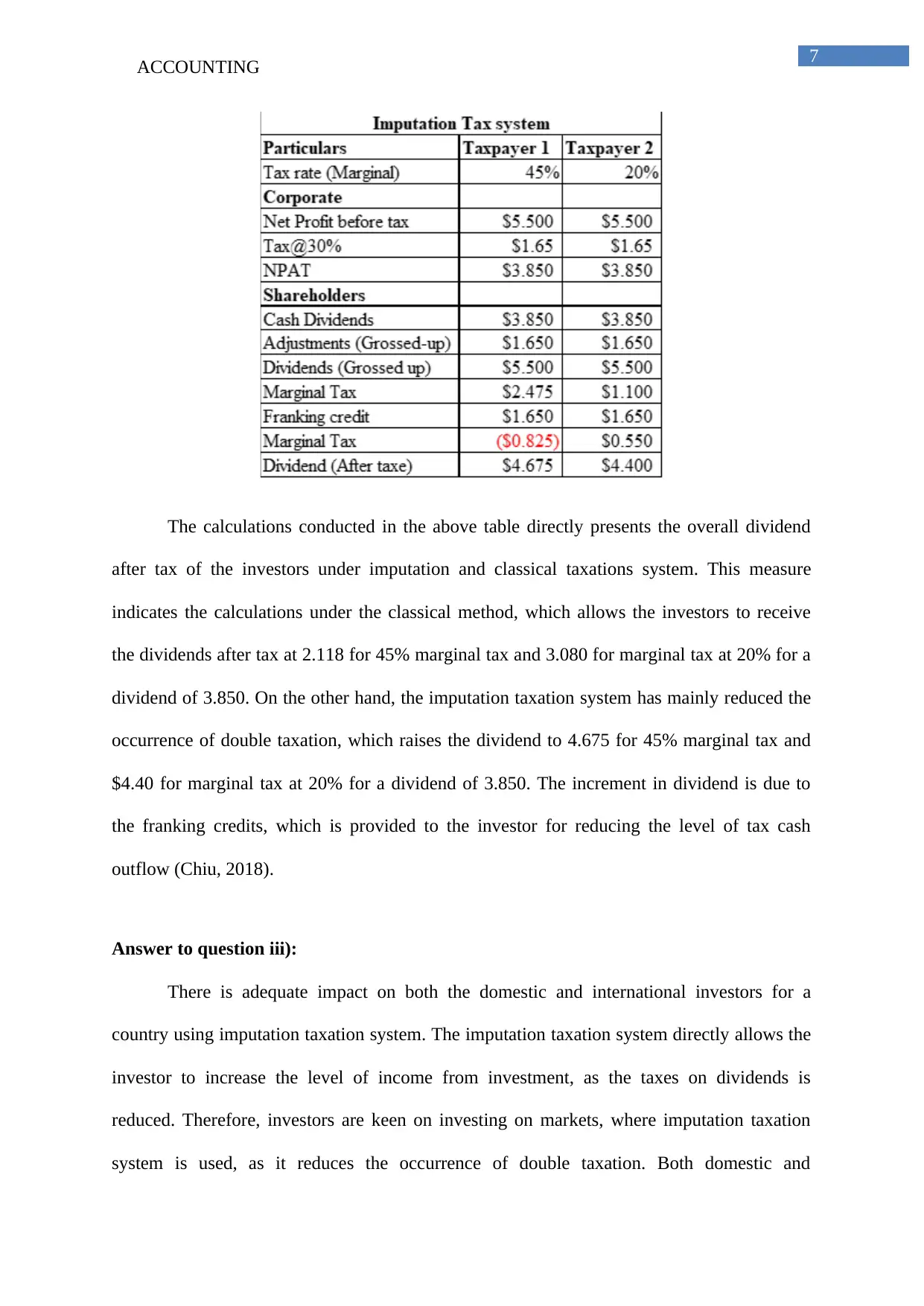
ACCOUNTING 7
The calculations conducted in the above table directly presents the overall dividend
after tax of the investors under imputation and classical taxations system. This measure
indicates the calculations under the classical method, which allows the investors to receive
the dividends after tax at 2.118 for 45% marginal tax and 3.080 for marginal tax at 20% for a
dividend of 3.850. On the other hand, the imputation taxation system has mainly reduced the
occurrence of double taxation, which raises the dividend to 4.675 for 45% marginal tax and
$4.40 for marginal tax at 20% for a dividend of 3.850. The increment in dividend is due to
the franking credits, which is provided to the investor for reducing the level of tax cash
outflow (Chiu, 2018).
Answer to question iii):
There is adequate impact on both the domestic and international investors for a
country using imputation taxation system. The imputation taxation system directly allows the
investor to increase the level of income from investment, as the taxes on dividends is
reduced. Therefore, investors are keen on investing on markets, where imputation taxation
system is used, as it reduces the occurrence of double taxation. Both domestic and
The calculations conducted in the above table directly presents the overall dividend
after tax of the investors under imputation and classical taxations system. This measure
indicates the calculations under the classical method, which allows the investors to receive
the dividends after tax at 2.118 for 45% marginal tax and 3.080 for marginal tax at 20% for a
dividend of 3.850. On the other hand, the imputation taxation system has mainly reduced the
occurrence of double taxation, which raises the dividend to 4.675 for 45% marginal tax and
$4.40 for marginal tax at 20% for a dividend of 3.850. The increment in dividend is due to
the franking credits, which is provided to the investor for reducing the level of tax cash
outflow (Chiu, 2018).
Answer to question iii):
There is adequate impact on both the domestic and international investors for a
country using imputation taxation system. The imputation taxation system directly allows the
investor to increase the level of income from investment, as the taxes on dividends is
reduced. Therefore, investors are keen on investing on markets, where imputation taxation
system is used, as it reduces the occurrence of double taxation. Both domestic and
Paraphrase This Document
Need a fresh take? Get an instant paraphrase of this document with our AI Paraphraser
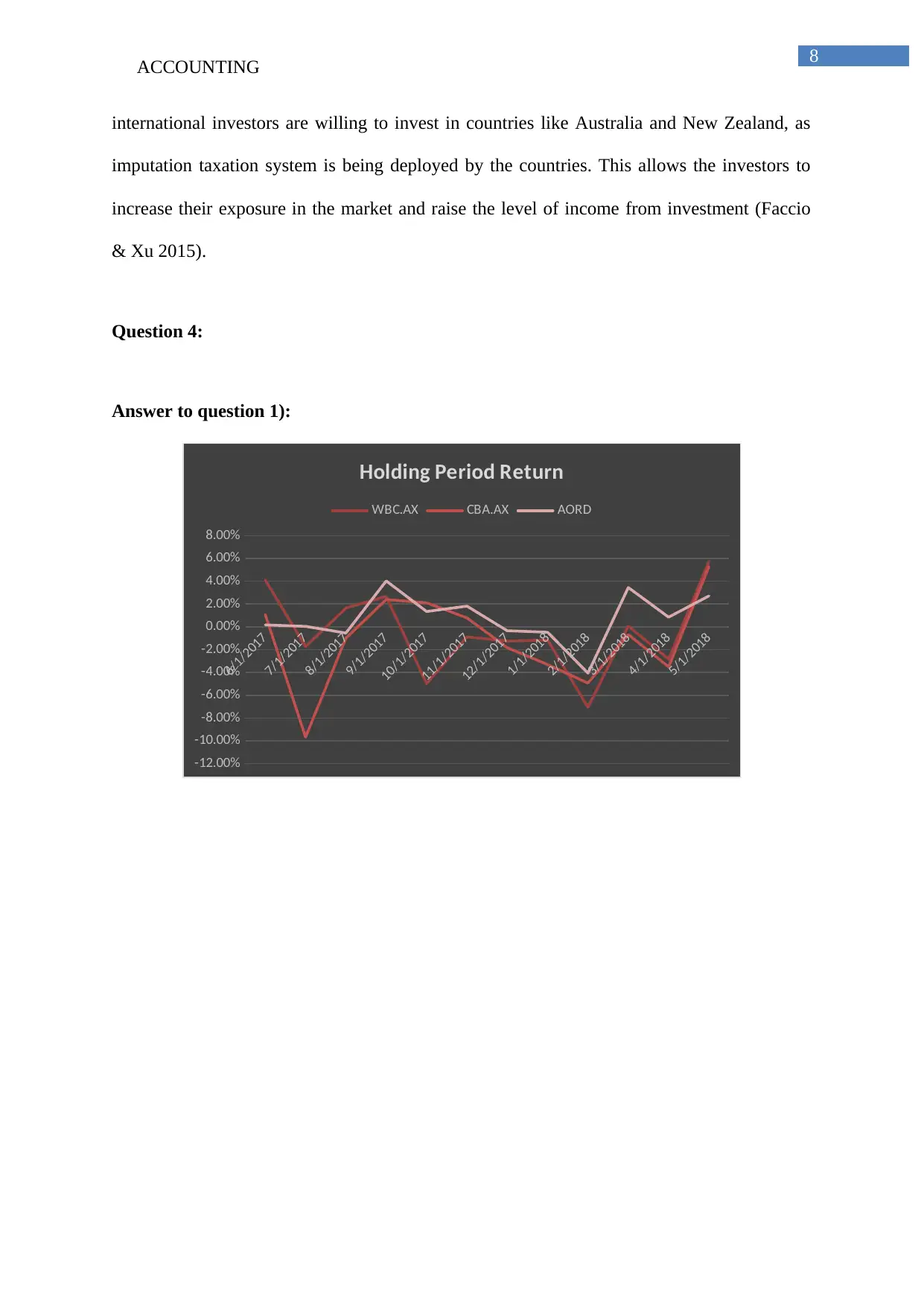
ACCOUNTING 8
international investors are willing to invest in countries like Australia and New Zealand, as
imputation taxation system is being deployed by the countries. This allows the investors to
increase their exposure in the market and raise the level of income from investment (Faccio
& Xu 2015).
Question 4:
Answer to question 1):
6/1/2017
7/1/2017
8/1/2017
9/1/2017
10/1/2017
11/1/2017
12/1/2017
1/1/2018
2/1/2018
3/1/2018
4/1/2018
5/1/2018
-12.00%
-10.00%
-8.00%
-6.00%
-4.00%
-2.00%
0.00%
2.00%
4.00%
6.00%
8.00%
Holding Period Return
WBC.AX CBA.AX AORD
international investors are willing to invest in countries like Australia and New Zealand, as
imputation taxation system is being deployed by the countries. This allows the investors to
increase their exposure in the market and raise the level of income from investment (Faccio
& Xu 2015).
Question 4:
Answer to question 1):
6/1/2017
7/1/2017
8/1/2017
9/1/2017
10/1/2017
11/1/2017
12/1/2017
1/1/2018
2/1/2018
3/1/2018
4/1/2018
5/1/2018
-12.00%
-10.00%
-8.00%
-6.00%
-4.00%
-2.00%
0.00%
2.00%
4.00%
6.00%
8.00%
Holding Period Return
WBC.AX CBA.AX AORD
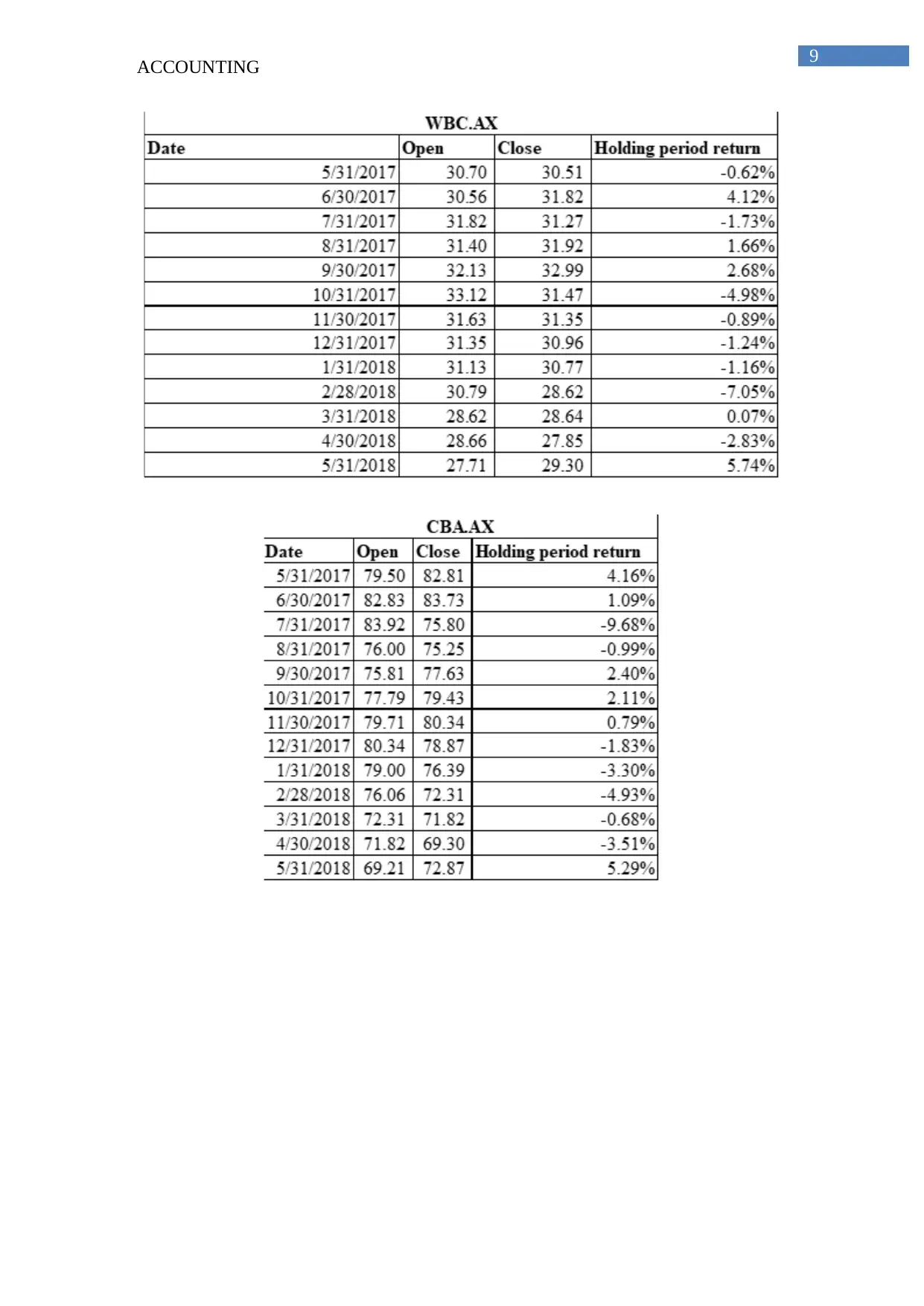
ACCOUNTING 9
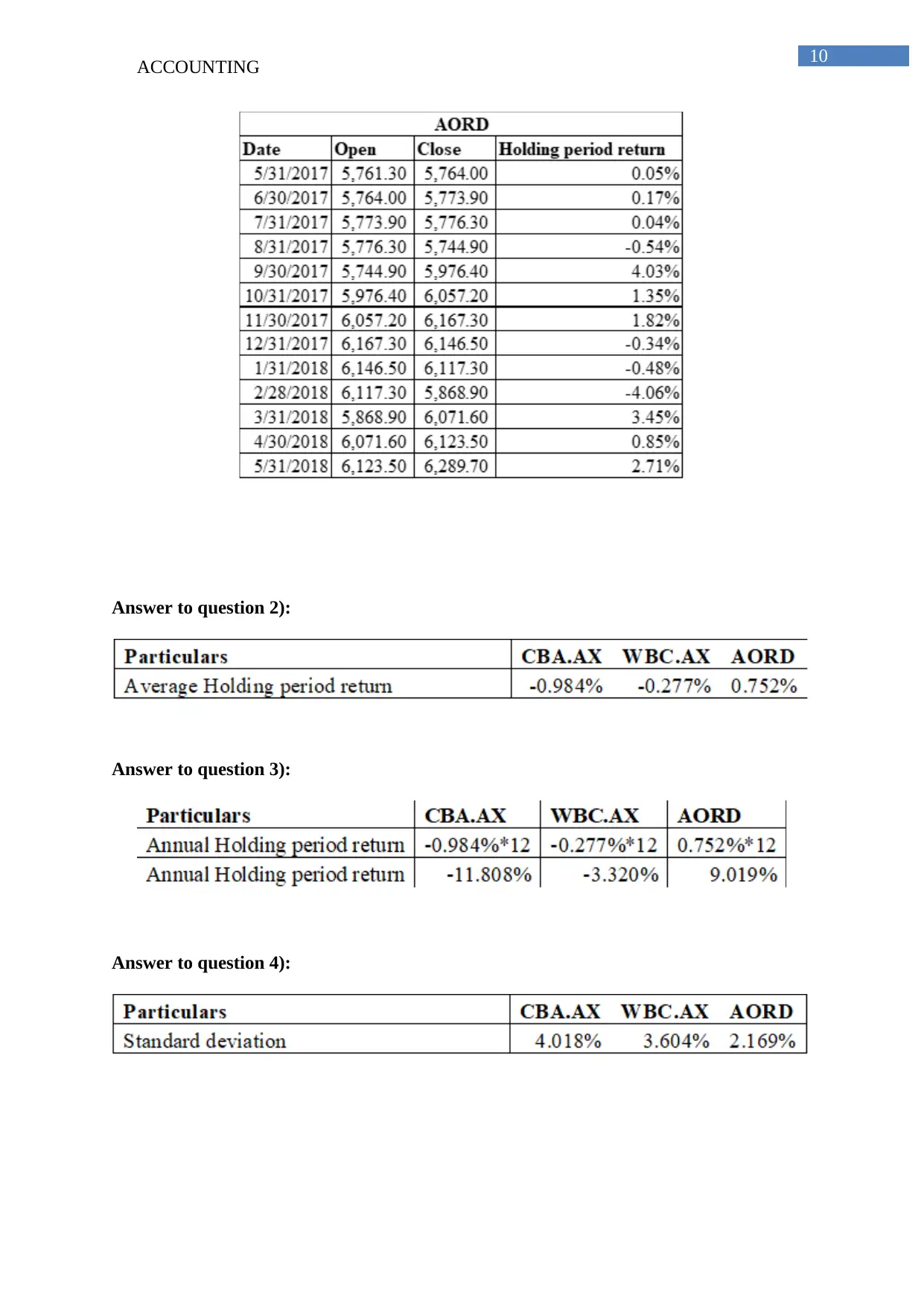
ACCOUNTING 10
Answer to question 2):
Answer to question 3):
Answer to question 4):
Answer to question 2):
Answer to question 3):
Answer to question 4):
Secure Best Marks with AI Grader
Need help grading? Try our AI Grader for instant feedback on your assignments.
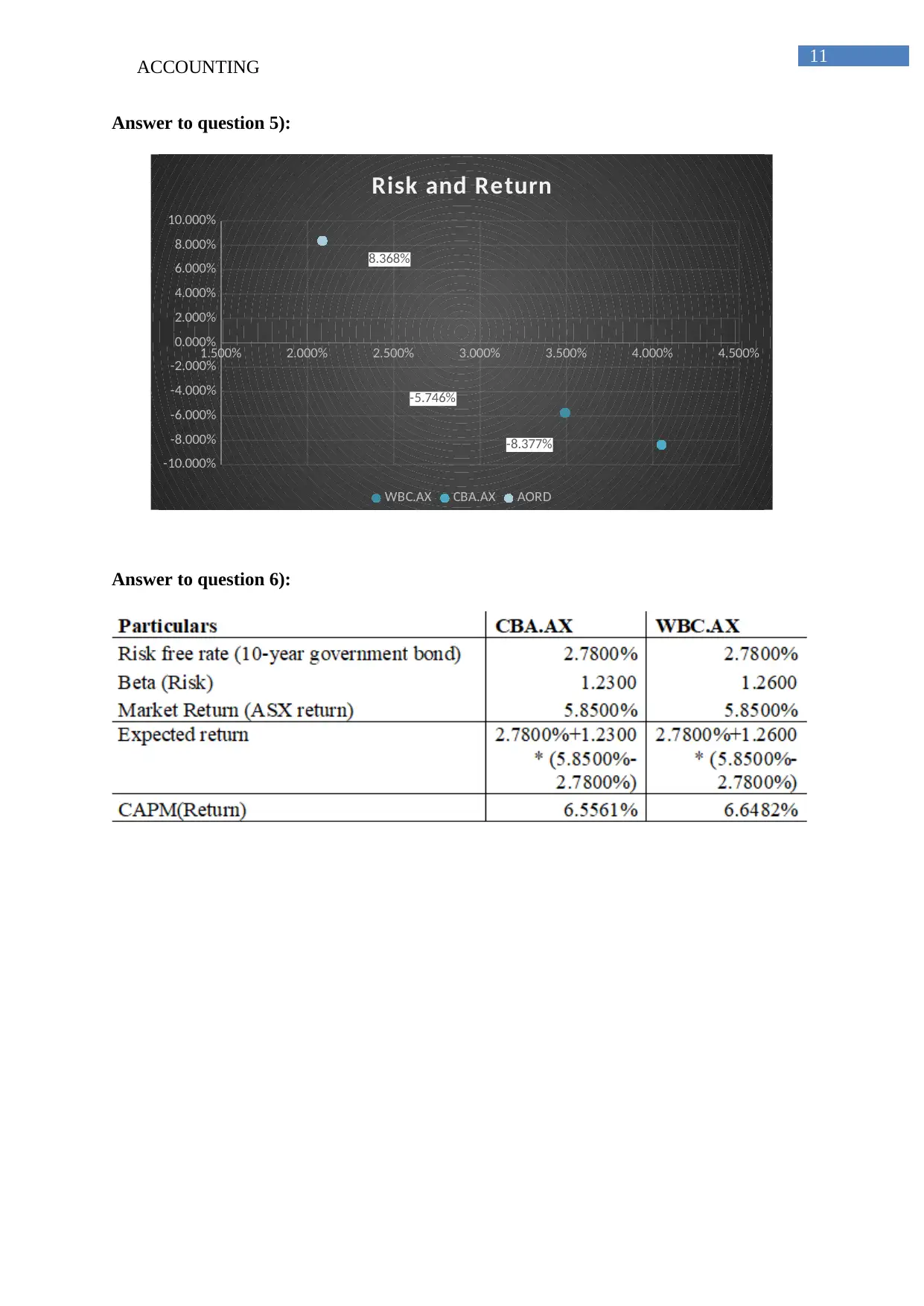
ACCOUNTING 11
Answer to question 5):
1.500% 2.000% 2.500% 3.000% 3.500% 4.000% 4.500%
-10.000%
-8.000%
-6.000%
-4.000%
-2.000%
0.000%
2.000%
4.000%
6.000%
8.000%
10.000%
8.368%
-8.377%
-5.746%
Risk and Return
WBC.AX CBA.AX AORD
Answer to question 6):
Answer to question 5):
1.500% 2.000% 2.500% 3.000% 3.500% 4.000% 4.500%
-10.000%
-8.000%
-6.000%
-4.000%
-2.000%
0.000%
2.000%
4.000%
6.000%
8.000%
10.000%
8.368%
-8.377%
-5.746%
Risk and Return
WBC.AX CBA.AX AORD
Answer to question 6):
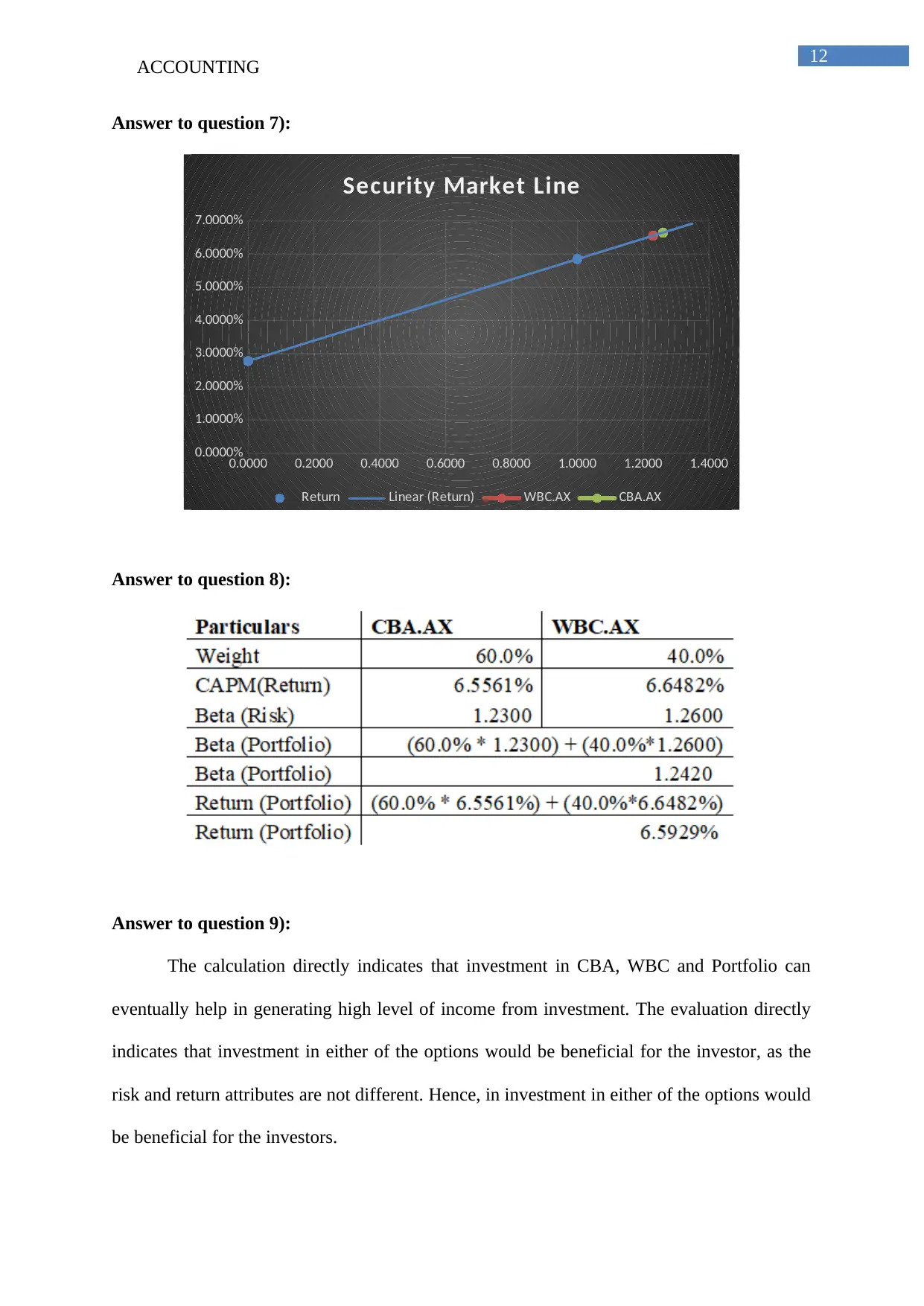
ACCOUNTING 12
Answer to question 7):
0.0000 0.2000 0.4000 0.6000 0.8000 1.0000 1.2000 1.4000
0.0000%
1.0000%
2.0000%
3.0000%
4.0000%
5.0000%
6.0000%
7.0000%
Security Market Line
Return Linear (Return) WBC.AX CBA.AX
Answer to question 8):
Answer to question 9):
The calculation directly indicates that investment in CBA, WBC and Portfolio can
eventually help in generating high level of income from investment. The evaluation directly
indicates that investment in either of the options would be beneficial for the investor, as the
risk and return attributes are not different. Hence, in investment in either of the options would
be beneficial for the investors.
Answer to question 7):
0.0000 0.2000 0.4000 0.6000 0.8000 1.0000 1.2000 1.4000
0.0000%
1.0000%
2.0000%
3.0000%
4.0000%
5.0000%
6.0000%
7.0000%
Security Market Line
Return Linear (Return) WBC.AX CBA.AX
Answer to question 8):
Answer to question 9):
The calculation directly indicates that investment in CBA, WBC and Portfolio can
eventually help in generating high level of income from investment. The evaluation directly
indicates that investment in either of the options would be beneficial for the investor, as the
risk and return attributes are not different. Hence, in investment in either of the options would
be beneficial for the investors.
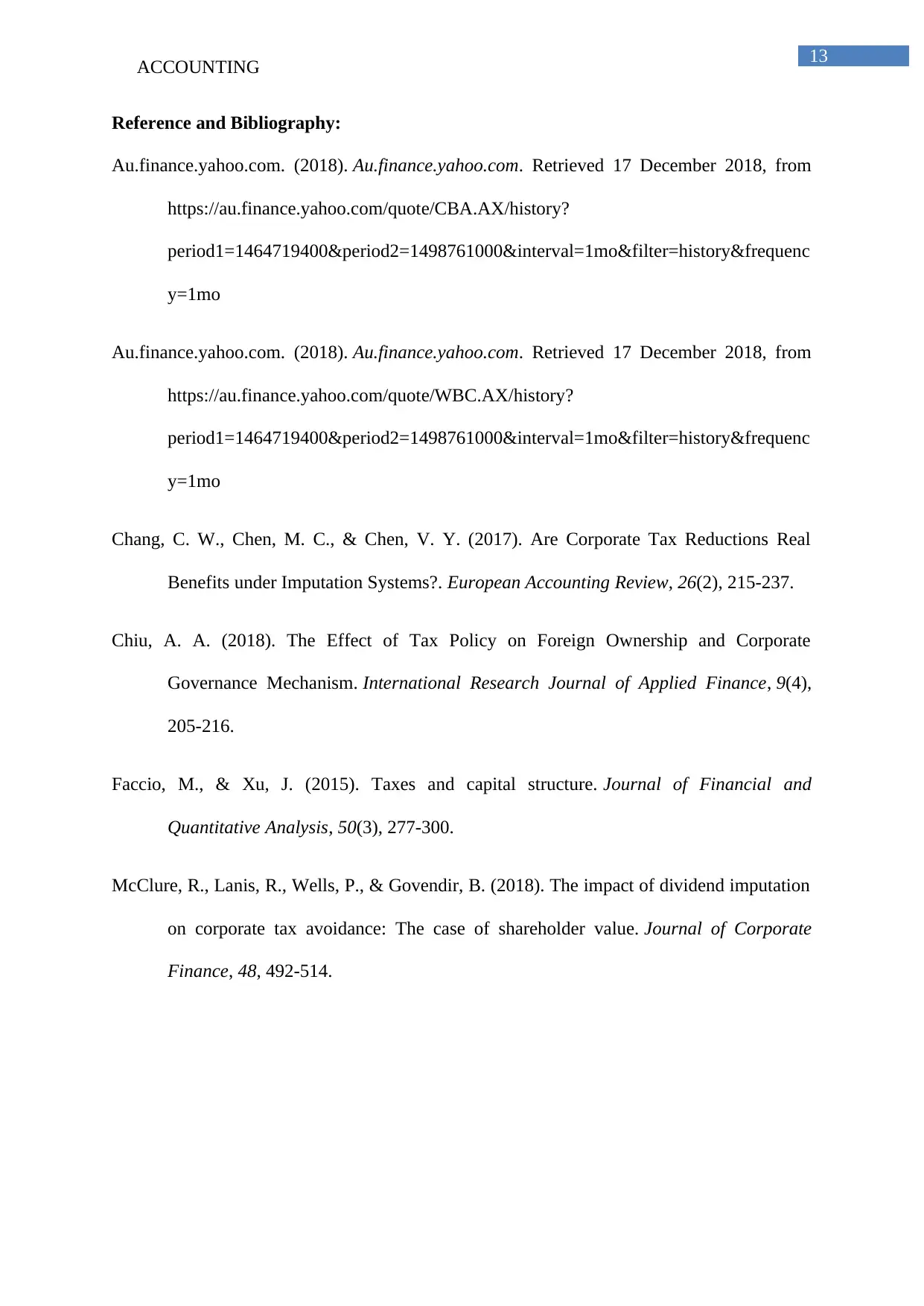
ACCOUNTING 13
Reference and Bibliography:
Au.finance.yahoo.com. (2018). Au.finance.yahoo.com. Retrieved 17 December 2018, from
https://au.finance.yahoo.com/quote/CBA.AX/history?
period1=1464719400&period2=1498761000&interval=1mo&filter=history&frequenc
y=1mo
Au.finance.yahoo.com. (2018). Au.finance.yahoo.com. Retrieved 17 December 2018, from
https://au.finance.yahoo.com/quote/WBC.AX/history?
period1=1464719400&period2=1498761000&interval=1mo&filter=history&frequenc
y=1mo
Chang, C. W., Chen, M. C., & Chen, V. Y. (2017). Are Corporate Tax Reductions Real
Benefits under Imputation Systems?. European Accounting Review, 26(2), 215-237.
Chiu, A. A. (2018). The Effect of Tax Policy on Foreign Ownership and Corporate
Governance Mechanism. International Research Journal of Applied Finance, 9(4),
205-216.
Faccio, M., & Xu, J. (2015). Taxes and capital structure. Journal of Financial and
Quantitative Analysis, 50(3), 277-300.
McClure, R., Lanis, R., Wells, P., & Govendir, B. (2018). The impact of dividend imputation
on corporate tax avoidance: The case of shareholder value. Journal of Corporate
Finance, 48, 492-514.
Reference and Bibliography:
Au.finance.yahoo.com. (2018). Au.finance.yahoo.com. Retrieved 17 December 2018, from
https://au.finance.yahoo.com/quote/CBA.AX/history?
period1=1464719400&period2=1498761000&interval=1mo&filter=history&frequenc
y=1mo
Au.finance.yahoo.com. (2018). Au.finance.yahoo.com. Retrieved 17 December 2018, from
https://au.finance.yahoo.com/quote/WBC.AX/history?
period1=1464719400&period2=1498761000&interval=1mo&filter=history&frequenc
y=1mo
Chang, C. W., Chen, M. C., & Chen, V. Y. (2017). Are Corporate Tax Reductions Real
Benefits under Imputation Systems?. European Accounting Review, 26(2), 215-237.
Chiu, A. A. (2018). The Effect of Tax Policy on Foreign Ownership and Corporate
Governance Mechanism. International Research Journal of Applied Finance, 9(4),
205-216.
Faccio, M., & Xu, J. (2015). Taxes and capital structure. Journal of Financial and
Quantitative Analysis, 50(3), 277-300.
McClure, R., Lanis, R., Wells, P., & Govendir, B. (2018). The impact of dividend imputation
on corporate tax avoidance: The case of shareholder value. Journal of Corporate
Finance, 48, 492-514.
1 out of 13
Related Documents
Your All-in-One AI-Powered Toolkit for Academic Success.
+13062052269
info@desklib.com
Available 24*7 on WhatsApp / Email
![[object Object]](/_next/static/media/star-bottom.7253800d.svg)
Unlock your academic potential
© 2024 | Zucol Services PVT LTD | All rights reserved.




